|
One of the fundamental requirements for the
control of action within an environment is the ability to perceive
the layout of objects and surfaces. No single source of information
about the relative distances of objects and surfaces can provide
the information required to perceive layout throughout the range
of distances required. However, in cluttered
well lit conditions typical of natural environments people are
very good at obtaining information about layout through the simultaneous
use of multiple cues.
The relative effectiveness of different sources
of information differs systematically with the distance of objects
and surfaces from the observer, and also with characteristics
of the observer and the environment (such as the size of objects,
the speed which an observer is moving through the environment,
and the nature of the terrain).
Considerable research has been undertaken
to describe sources of distance information, and Cutting &
Vishton (1995) describe seven independent
sources, summarised below. A number of outstanding questions
remain, however, regarding how multiple cues are combined in
the perception of layout under different conditions.
Pictorial Cues
Occlusion. An
opaque object which hides, or partially obscures another object
provides ordinal information about the layout of objects in the
environment. Occlusion is an effective cue throughout the complete
visible range of distances.
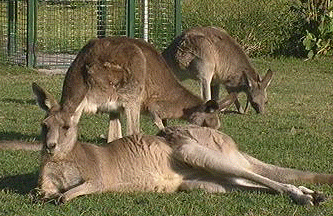
An example of effective and ineffective occlusion cues. The
cue is not effective where the contour is unclear.
Relative size/relative density. The size of the retinal image projected by objects
of the same size differs at different distances (relative size),
and the density of the retinal images of regularly placed clusters
of objects, or textures also varies with distance of the objects
or textures from the observer (relative density). Relative size
and density can yield scaled information, and is effective over
the complete visible range of distances.
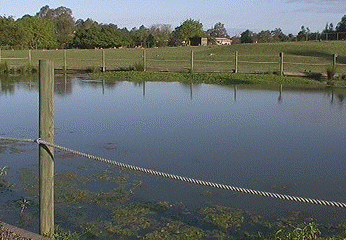
An example of relative size
 . . 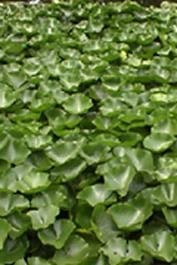
Examples of relative density
Height in the visual field. Ordinal information about the distance of the objects
is available from the vertical location in the visual field of
the bases of objects resting on the (horizontal) ground. The
bases of more distant objects are located higher in the visual
field than the bases of closer objects. Scaled information is
available relative to the observer's eye height. The cue is not
useful at very close distances, is maximally effective at distances
of about 2m, and decreases in effectiveness to a distance of
about 100 m.
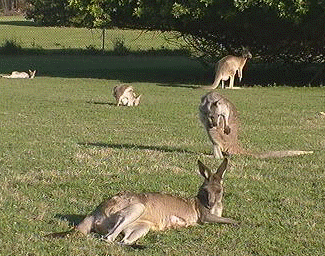
Example of height in the visual field indicating
distance
Aerial perspective.
Atmospheric interference causes distant objects to become bluer,
and decreased in contrast relative to nearer objects. The distance
over which the cue is effective varies with atmospheric conditions,
but increases in effectiveness from distances beyond 100m before
decreasing in effectiveness at distances beyond several kilometres.
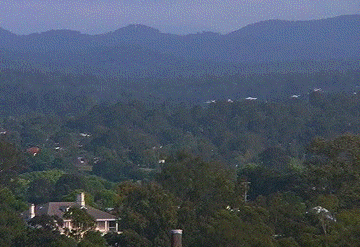
An example of aerial perspective
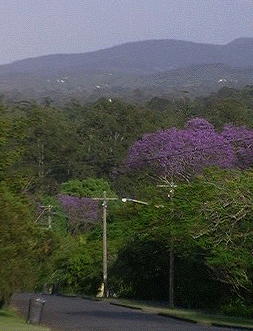
Another example of aerial perspective, and one in which relative
size conflicts with the height in the visual field of the object
(power pole bases) indicating that the ground is sloping away
from the observer.
Motion cues
Motion perspective.
The apparent motion of objects caused by movement of the observer
through the environment provides information about the layout,
for example, near objects appear to move past a moving observer
more rapidly than far objects. Information is not available about
objects which are too close relative to the velocity of movement
to be tracked, and decreases in effectiveness to about 100 m,
again, depending on the velocity of movement (useful at greater
distances when velocity is high).
Motion perspective
Binocular cues
Convergence.
Maintaining single vision of proximal visual targets requires
the extra-ocular muscles of the eyes to rotate the visual axes
toward each other. Fixation of closer objects requires a greater
degree of convergence, and corresponding increase in the activation
of the extraocular muscles (medial recti) to achieve this convergence.
Information from the extra-ocular muscles regarding the degree
of vergence thus provides information about the distance of objects
from the observer. The cue is only effective at very small distances
(< 2 m). While changes in accommodation (the shape of the
lens) necessary to focus on objects has traditionally been accepted
as a second extraocular cue for distance, recent evidence suggests
that accommodation provides little, if any, useful information
(Tresilian & Mon-Williams, in press).
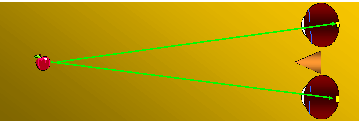
Vergence changes with distance
Binocular disparity.
The image of same object viewed through two eyes is projected
to different locations on the retinas of the eyes. The relative
position of the images provides information about the distance
of the object from the eyes. Disparity provides greatest information
for very close objects and decreases in effectiveness to about
10 m.
Summary
No single source of information about the
relative distances of objects and surfaces can provide the information
required to perceive layout throughout the range of distances
required. People are very good at obtaining
information about layout in the cluttered natural environement
through the simultaneous use of multiple cues.
However, even in tasks, such as endoscopy,
where available cues are reduced ingenious methods can be adopted
to provide the observer with the necessary layout information
(see Voorhorst,
1998).
The relative importance of each cue varies
with distance. For objects within personal space (< 2m) occlusion,
retinal disparity, relative size, convergence and motion perspective
provide useful information (in decreasing order of effectiveness).
For objects within action space (>2 < 30m) occlusion, height
in the visual field, binocular disparity, motion perspective
and relative size are useful; while for objects and surfaces
in vista space (> 30m) occlusion, height in the visual field,
relative size and aerial perspective cues provide the information
which allow actions to be controlled.
Required Reading
Cutting &
Vishton (1995)
|
